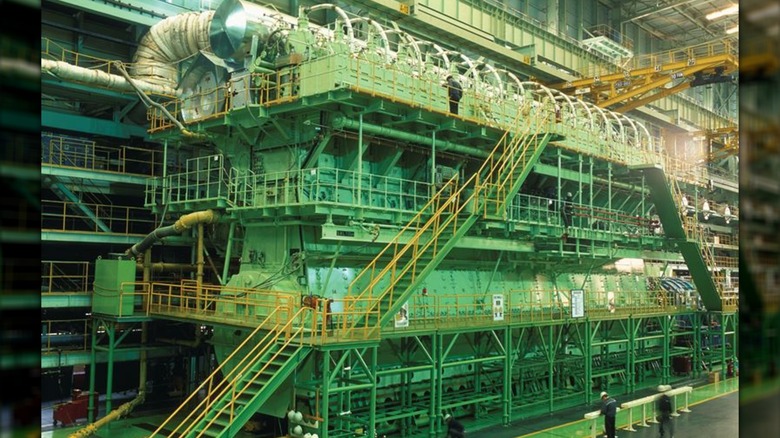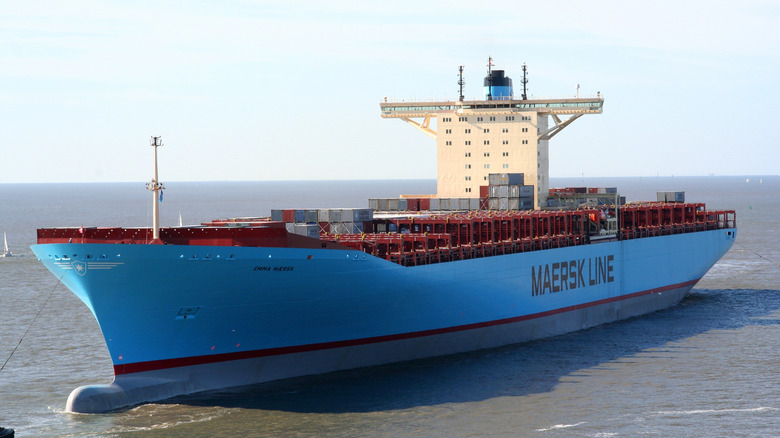
What's the biggest engine you can think of off the top of your head? There are certainly still some colossal motors in the automotive market,
as big as Bugatti's 8-liter W16. If you're thinking outside of what's street legal, you might have gone with the colossal Caterpillar C175 Engine. The heart of the 797F mining truck, the V20 easily outsizes anything road-legal, with its 106 liters and four turbos cranking out 4,000 horsepower.And still, comparing any of these engines to what we're looking at today
is like putting the Earth against Saturn. Weighing in at 2,300 tonnes (2,535 short tons) and standing 44 feet tall, the block's bore and stroke make the combustion chamber just large enough to stand in. It's built to power the largest cargo ships ever built, and can reach six figures of horsepower. Meet the Wärtsilä-Sulzer RTA96-C: the most powerful reciprocating engine in the world, and certainly not just a proof of concept. The gargantuan inline-14 has shown true utility over nearly 19 years of service, and has been the perfect fit for some of the biggest jobs on the open seas.
Read more: These Are The Most Forgettable Cars
The World's Largest Engine
The two-stroke diesel was originally produced by Finnish manufacturer Wärtsilä, which says that at 102 rpm, the RT-Flex makes an incredible 108,920 horsepower. An impressive number itself, but that adds up to the engine making over 5 million pound-feet of torque. Yes, 5 million.
It's genuinely difficult to wrap your brain around the scale of the engine's power, but slightly less mind-boggling is how the RT-Flex also chugs through fuel oil, going through nearly 1,700 gallons an hour in its highest-efficiency mode. Expected for an engine that weights more than most boats and displaces over 25,000 liters, but with big size also comes major efficiency.
We can find out just how efficient it is with the brake specific fuel consumption (BSFC), which tells us that this bad boy goes through about .26 pounds of fuel per horsepower each hour. When most automotive engines rarely drop under .4 lb/hp/hr, that shows just how light the Wärtsilä is on its tank. Moreover, the engine at it's most efficient setting has a thermal efficiency of 50%, essentially meaning that half of the fuel burned is converted into power. Most auto engines have a range of 25%-30%, with the only engines even close are the ones seen in Formula 1. Not bad for an engine around four stories tall.
The Ship It Was Built For

The RT-Flex was made for the Danish container ship Emma Mærsk. At 1,300 feet long and 183 feet wide, it trumps the size of America's Gerald R. Ford-class aircraft carriers, and gives it the space to carry over 11,000 cargo containers, when it launched in 2006 it easily became the largest container ship ever built. And thanks to the Wärtsilä, the Emma Maersk can easily cruise at over 30 mph.
An absolute marvel of its time, but in the nearly two decades since its launch, container ships have only gotten bigger, and it's unlikely that we'll see a design and engine like this again. Despite single-engine designs having incredible levels of efficiency, newer, larger container ships have returned to twin-engine design. With each engine driving a separate propeller, going separate allows a better distribution of pressure, and that extra efficiency outweighs the extra fuel and maintenance costs. A major win for shipping companies, but heartbreaking that the 16-cylinder beast may never be needed again.
If they are, these mechanical monstrosities can still be bought brand new. WinGD, a venture company Wärtsilä and China State Shipbuilding Corporation has been offering them since 2015, with Hyundai Heavy Industries building them in South Korea. Should 14 be too many cylinders for you, WinGD also offers smaller variants, with the smallest format being an inline-6. Only a matter of time before someone tries cramming one in a Volvo 240.
Want more like this? Join the Jalopnik newsletter to get the latest auto news sent straight to your inbox...
Read the original article on Jalopnik.













